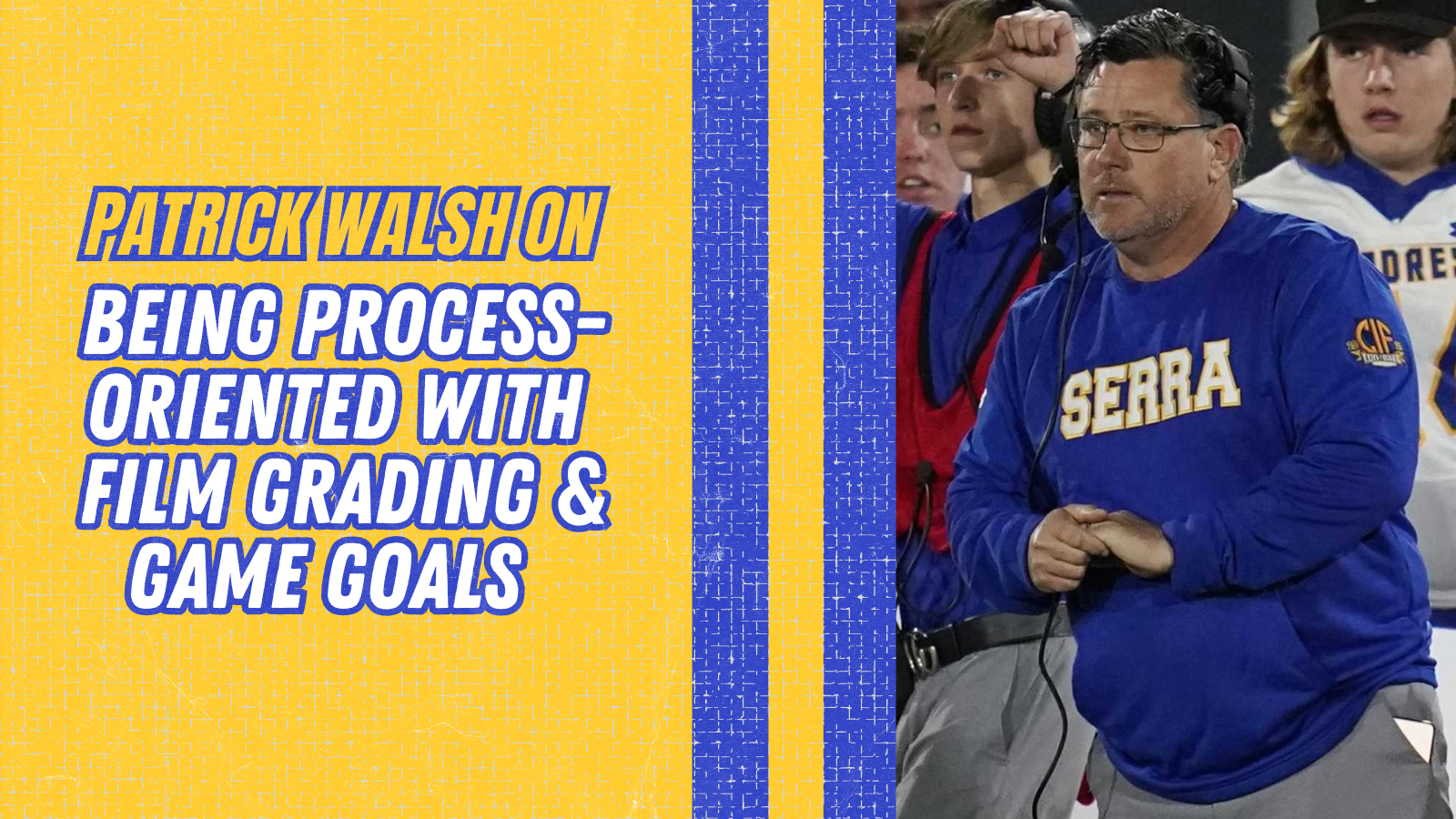
Hall of Fame Coach Bill Walsh was known for his process-oriented approach to the game. He once said, “The score takes care of itself if you take care of the process. It’s not about playing for the scoreboard, but about preparing in a way that will lead to success.” It’s a sound approach that allows a coach to lead his team to reach their full potential. A high school coach of the same last name, Patrick Walsh, the head coach of Serra High School in California, takes a process-oriented approach to developing his team, and the tools for this are his game goals, his film grading method, and his use of technology.
“The score takes care of itself if you take care of the process.
Bill Wash, Hall of Fame Coach
It’s not about playing for the scoreboard, but about
preparing in a way that will lead to success.”
The Role of Football Film Grading in Improvement
Film grading has become a primary tool for player development. Coach Walsh relies on a simple but effective system to keep his team focused on the process rather than the scoreboard. “The scoreboard can be a great liar,” says Walsh, stressing that the final result doesn’t always reflect the effort and execution.
The scoreboard can be a great liar.
Patrick Walsh, Head Coach, Serra High School
In his grading system, players receive either a one or a zero on each play, depending on whether they executed their role correctly. Walsh keeps it straightforward to ensure feedback is clear, concise, and actionable. Players aim to achieve a grade of 80% or higher, setting a high standard for performance.
Specific Grading Criteria
- One or Zero System: Players receive a score of one for correctly executing their assignment and a score of zero if they do not.
- 80% or Higher: The target grade for each player is 80%, although the collective goal for the team is to score above 75% on average.
- No Overcomplication: Walsh avoids complex grading systems (e.g., no bonus points for exceptional plays or penalties for errors). He believes that a player either does their job or they don’t.
This grading system allows Walsh and his assistant coaches to quickly identify areas for improvement. The position coach has a “hawk’s eye” for the issues causing zeros as well as the strengths the players are developing. By focusing on consistent feedback through their grading system, players receive the necessary instruction to improve their skills continually.
Game Goals for Football Success
While film grading offers valuable insights into individual performance, game goals provide a broader framework for measuring team success. Walsh designed a 12-goal system with four for offense, four for defense, and four for special teams, that the team aims to achieve each week. These game goals for football help focus the team on execution, keeping them process-oriented and driving continuous improvement.
Offensive Goals
- 1.7 First Downs Per Drive: Averaging at least 1.7 first downs per drive indicates sustained offensive success and consistent ball movement.
- Two Turnovers or Less: Limiting turnovers to two or fewer per game is key to maintaining possession and reducing risks. Walsh notes that they developed this goal while they were an option team, but he feels limiting to 1 or 2 turnovers works as a goal
- 75% Red Zone Scoring: When the offense reaches the 25-yard line, they must score on 75% of drives through a field goal or touchdown.
- 12% Efficiency Rule: Learned from former Maryland coach Ralph Friedgen, this rule tracks any fumbles, sacks, penalties, or interceptions divided by total plays. The goal is to keep this number at or below 12%.
Defensive Goals
- 17 Points or Fewer: Allowing 17 points or fewer is a key metric for defensive success, especially against the best teams.
- Three Three-and-Outs: Forcing at least three three-and-outs per game keeps the opposing offense in check and helps control momentum.
- 20% Chaos Rate: This goal measures defensive disruption and includes forcing fumbles, sacks, interceptions, and penalties that hinder the opponent’s progress. The team aims to hit a 20% chaos rate based on total plays.
- Two Takeaways or More: Securing two or more turnovers can dramatically change the game’s momentum, leading to scoring opportunities.
Special Teams Goals
- 75% Kickoffs Inside the 25: The goal is to force the opponent to start their drives at or inside the 25-yard line on at least 75% of kickoffs.
- 32.5 Yards Average Net Punt: Maintaining a net punting average of at least 32.5 yards helps flip the field and prevent opponents from gaining advantageous field position.
- Kickoff Return Average Start at 35: The team aims to start at or beyond the 35-yard line on kickoff returns, giving the offense favorable field position.
- No Turnovers or Missed PATs: The goal is to have no special teams turnovers or missed PATs/field goals, ensuring that mistakes don’t cost the team valuable points.
By clearly defining these goals and keeping the number of goals manageable, Walsh keeps his team focused on key performance aspects, reinforcing a process-driven approach over results.
Using Technology to Enhance Coaching
In addition to film grading and setting game goals, Coach Walsh leverages technology to further enhance his team’s performance. One of the standout tools he uses is drone footage to capture a bird’s-eye view of both practices and games. This allows his team to review plays from an angle that gives a comprehensive look at every player’s movement and decision-making.
“We upload that film every single night to Hudl so the kids can review it,” Walsh explains. “Our position coaches watch practice film every night and put notes on Hudl to share with the kids.” This use of technology streamlines the feedback process, guaranteeing that every player has the opportunity to make adjustments and improvements before the next practice or game.
Even programs with fewer resources can adopt this approach. Walsh points out that drones have become affordable, making this technology accessible to nearly any high school program. For those without drones, more straightforward methods, like filming from a high vantage point using an iPad, can still provide valuable insights. By combining film grading with the detailed analysis of drone footage, Walsh’s staff maximizes the potential of their practice time, creating a clear pathway for improving football skills with film.
Additionally, the team recently integrated in-game analytics to help adjust real-time strategy. These tools allow coaches to quickly process data on both offense and defense, avoiding missed opportunities for adjustments.

Book a Demo with Modern Football Technology
A Winning Formula
As both Coach Walshes believe, success is built on a solid process. Coach Patrick Walsh keeps his team focused on continuous improvement by implementing film grading, setting clear game goals, and utilizing cutting-edge technology. This approach provides valuable feedback, keeps players motivated, and helps his team stay competitive regardless of the final score. He is keeping the focus on the process that leads to consistent success.


